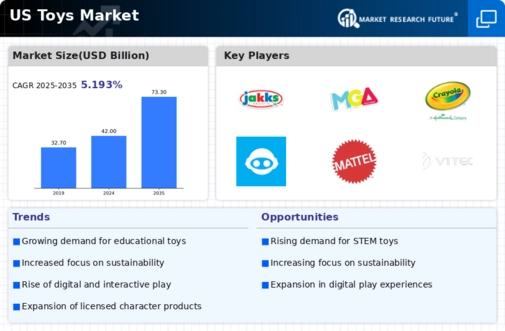The US Toys Market is characterized by a dynamic competitive landscape, driven by diverse consumer preferences and innovations that continuously reshape product offerings. Major manufacturers are aggressively positioning themselves through strategic marketing, product diversification, and leveraging technology to enhance customer experiences. The market has seen a significant shift towards interactive and electronic toys, trending with generational demands for entertainment and educational value. Additionally, the influence of trends from media and pop culture has led to an aggressive licensing strategy among key players.
The competition remains fierce, with companies constantly adapting to market fluctuations and consumer expectations to maintain or improve their market share.JAKKS Pacific has established itself as a notable contender in the US Toys Market, leveraging its broad portfolio of products that appeal to various age groups. The company’s strengths lie in its capability to develop innovative toys that not only entertain but also promote educational values, catering to the growing interest among parents for developmental products. JAKKS Pacific has successfully created strong tie-ins with popular media franchises, enabling them to capture the attention of younger audiences.
Additionally, the company utilizes effective marketing strategies and partnerships to enhance its visibility within the market. By focusing on product quality and creativity, JAKKS Pacific continues to strengthen its position, fostering brand loyalty among consumers and maintaining a competitive edge.MGA Entertainment holds a significant presence in the US Toys Market, primarily recognized for its development of popular and award-winning toys. The company is well-known for iconic lines that resonate with children and parents alike, focusing on creativity, imaginative play, and entertainment value. Key products include fashion dolls, collectible toys, and interactive playsets that frequently reflect current trends.
MGA Entertainment's strengths lie in their agile product development pipeline, allowing them to quickly adapt to trends and implement market feedback. Furthermore, the company has engaged in strategic mergers and acquisitions to enhance its market reach and bring fresh innovation into its product lines. Through these efforts, MGA Entertainment has positioned itself as a formidable player, continuously expanding its influence in the highly competitive US Toys Market.

























